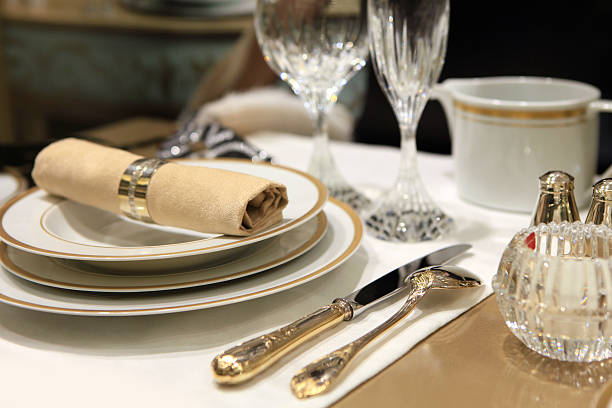
Dining Etiquette and Its Importance:
Dining etiquette, often overlooked in our fast-paced and modern world, plays a crucial role in our social interactions, personal relationships, and professional life. The way we conduct ourselves at the dining table reflects our upbringing, education, and cultural awareness. In this blog, we will delve into the significance of dining etiquette and explore its various aspects, from table manners to the art of conversation. By the end of this article, you’ll have a comprehensive understanding of why dining etiquette matters and how it can impact your life.
Section 1: The Importance of Dining Etiquette:
1.1. First Impressions Matter
They say you never get a second chance to make a first impression, and this holds true even at the dining table. When you exhibit proper dining etiquette, you immediately convey to others that you are polite, well-mannered, and considerate. This positive first impression can go a long way in personal and professional relationships.
1.2. Enhances Personal Relationships
Good dining etiquette fosters stronger personal relationships. Whether you’re on a first date, sharing a meal with your family, or enjoying a romantic dinner with your partner, displaying proper manners can make the experience more enjoyable for everyone involved. It promotes a sense of respect and consideration for each other, ultimately strengthening the bond between individuals.
1.3. Career Advancement
In the professional world, dining etiquette can play a significant role in career advancement. Business dinners and networking events are common, and your behavior at these gatherings can impact your professional reputation. Knowing how to navigate a formal dining setting can give you an edge in making a positive impression on potential employers or clients.
1.4. Cultural Awareness and Respect
Understanding and practicing dining etiquette is a sign of cultural awareness and respect. Different cultures have their own customs and rules regarding dining, and by adhering to them, you show respect for the traditions and values of others. This cultural sensitivity can help bridge gaps and build bridges across diverse groups.
Section 2: Table Manners
2.1. Seating Arrangement
Proper table manners begin with seating. Knowing where to sit in relation to your host or the most senior person at the table is essential. At a formal event, you should wait for the host to indicate your seat, whereas in casual settings, you can choose your place.
2.2. Napkin Use
When you sit down, unfold your napkin and place it on your lap. Use your napkin to blot your mouth, not to wipe your entire face. If you need to leave the table temporarily, place your napkin neatly on your chair or to the left of your plate.
2.3. Utensil Usage
Understanding the use of utensils can be intimidating for some, but it’s relatively straightforward. Start with the utensils on the outside and work your way in with each course. Forks go on the left, and knives and spoons go on the right. Use your utensils from the outside in, and when you’re finished, place them on the plate in a specific position to signal the server that you’re done.
2.4. Chewing and Swallowing
Chew your food with your mouth closed and avoid talking while chewing. Take small, manageable bites to make this easier. Swallow your food before taking another bite, and don’t rush through your meal.
2.5. Dining Pace
Try to match your dining pace with the others at the table. Eating too quickly or too slowly can make others uncomfortable. It’s important to enjoy your meal but also engage in conversation and be aware of the flow of the meal.
2.6. Elbows off the Table
One of the most basic rules of table manners is to keep your elbows off the table. Resting your wrists or forearms on the table is acceptable, but not your elbows. This rule promotes good posture and prevents you from crowding your dining companions.
2.7. Passing Food
If you’re sharing dishes, pass them to your right. Avoid reaching across the table for items; instead, ask for them to be passed to you. Use serving utensils when available, and never use your own fork or spoon to serve yourself from communal dishes.
Section 3: The Art of Conversation
3.1. Appropriate Topics
Engaging in conversation during a meal can enhance the dining experience, but it’s crucial to choose appropriate topics. Avoid controversial or negative subjects like politics, religion, or personal problems. Opt for light and positive subjects that can be enjoyed by all at the table.
3.2. Listening Skills
Good conversational etiquette involves active listening. Give your full attention to the speaker, maintain eye contact, and show interest in what they are saying. Avoid interrupting or dominating the conversation, and be respectful of differing opinions.
3.3. Technology at the Table
In today’s digital age, it’s common for people to have their phones at the dining table. However, it’s best to keep them out of sight and on silent mode during a meal. Engaging with your device can be seen as disrespectful to those at the table, and it can hinder the flow of conversation.
Section 4: Special Considerations
4.1. Food Allergies and Dietary Restrictions
If you have food allergies or dietary restrictions, it’s essential to communicate this with your host or the restaurant staff in advance. This allows them to make accommodations for your needs and ensures a more comfortable dining experience.
4.2. Thanking the Host
At the end of the meal, express your gratitude to the host for the invitation and the meal. A simple thank you is a sign of appreciation and respect for their hospitality.
4.3. Leaving the Table
When you need to leave the table before the meal is finished, politely excuse yourself and leave quietly. It’s considerate to wait for a lull in the conversation or for a break between courses.
Section 5: Conclusion
In conclusion, dining etiquette is not just a set of rigid rules; it’s a valuable skill that can significantly impact your personal and professional life. It shapes the way others perceive you, fosters stronger relationships, and promotes cultural understanding. By mastering table manners and the art of conversation, you can navigate various dining settings with confidence and grace.
Remember that dining etiquette is not about being stuffy or formal. It’s about being considerate, respectful, and making those around you feel comfortable and valued. So, whether you’re at a family dinner, a business lunch, or a romantic date, practicing good dining etiquette is a sure way to leave a positive and lasting impression on those with whom you share a meal.

RakeshChauhan
Related Posts

Why Choose BCA Program? – Geeta University
Why Choose BCA Program? – Geeta University The country’s largest employer is the information technology sector, which is projected to grow over the coming many

What To Do After BCA? – Best Career Options After BCA – Geeta University
What To Do After BCA? – Best Career Options After BCA – Geeta University Bachelor of Computer Application, or BCA. Data structures, database systems, and

Decoding DNA: The Genetic Blueprint of Life
Introduction: Deoxyribonucleic acid, more commonly known as DNA, is a molecule that holds the key to life as we know it. It serves as the


